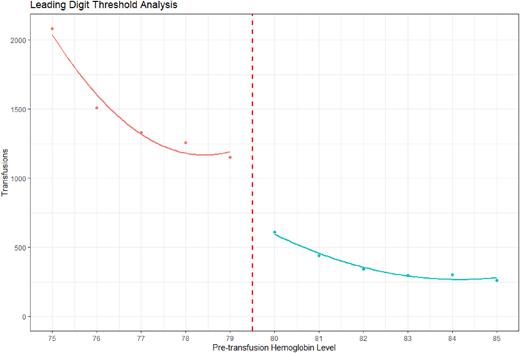Abstract
Leading-digit bias is a heuristic whereby people overemphasize the left-most digit when evaluating numbers (eg 19.99 vs 20). We hypothesized that leading-digit bias influences the interpretation of hemoglobin (Hb) values and therefore red cell transfusion decisions among hospitalized patients.
To test our hypothesis, we examined all inpatient red cell transfusions at the University Health Network from January 2016 to September 2021 (n=226,378 units; 4 months missing).
We performed a retrospective analysis of pre-transfusion Hb levels compared the frequency of transfusion at 79 vs. 80 g/L in a quadratic regression discontinuity design. Secondary analysis explored other leading-digit thresholds and Benford numbers served as tracer analyses. All analyses performed using R-Studio Version 4.0.2.
Our primary analysis included 9,585 red cell units, of which 1,150 were transfused at Hb=79 and 610 at Hb=80. Regression discontinuity analysis showed the threshold accounted for 572 additional red cell units transfused (p=0.006) (Figure 1). The effect was consistent across all subgroups larger than 5000, present in data with and without exclusions, and absent for Benford numbers.
Our study is the first to establish leading-digit bias in red cell transfusion. Our findings might be translated into research utilizing quasi-experimental methodology and inform guidelines for transfusion thresholds.
Figure 1. Unadjusted regression discontinuity analysis of pre-transfusion hemoglobin (g/L) comparing transfusion frequency above and below bias threshold
Disclosures
No relevant conflicts of interest to declare.
Author notes
∗Asterisk with author names denotes non-ASH members.


This feature is available to Subscribers Only
Sign In or Create an Account Close Modal